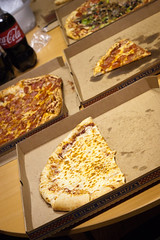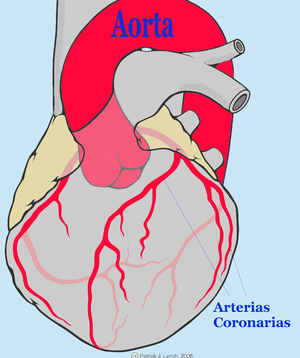 Image by DJ Lein via Flickr Image by DJ Lein via Flickr |
| Pizza from Costco Wholesale. |
You'll feel nauseous. When you try to eat, familiar foods will taste funny -- for days or weeks -- and you'll shed pounds without even trying.
I call this the Major Operation Diet. The doctors will put you to sleep and you'll wake up a new, slimmer you, with more weight loss ahead.
Nearly 14 days after I had open-heart surgery, my weight continues to fall. I weighed around 193 pounds today, compared with about 200 pounds on Sept. 20, the day I was released from the hospital.
My last food was at 10 p.m. the night before the operation, on Sept. 16, and I didn't have solid food again until more than 48 hours later in the recovery room -- a couple of cups of diet lemon ices.
Later, all the meals I was served at Englewood Hospital and Medical Center in Englewood were suitable for a diabetic, even though I'm not one. They were low-fat and bland, without salt or sugar.
My heart murmur wasn't related to my diet -- and my coronaries were clean and required no bypasses -- so why couldn't I resume my normal diet right away, and have something celebratory in the hospital -- like a gooey slice of pizza and a glass of red wine?
After all, I had survived an open-heart operation -- a major invasion of my body. But I never received any special recognition of that accomplishment -- not in food, not in any other way.
When I got home on Sept. 20, I returned to my normal diet right away -- with no adverse affects.
That meant real, caffeinated coffee in the morning; salt to season my food, low- and full-fat cheeses; lots of wild-caught fish, salads and sauteeed greens; and a generous glass of Bordeaux with dinner once or twice in the past 10 days.
My blood pressure today was 121 over 67.
I resumed eating Korean food almost immediately, including spicy cabbage kimchi. On Saturday night, we tried a new Mexican restaurant in Englewood.
After visiting my cardiologist on Wednesday, we drove over to H Mart in Englwood looking for a dinner of prepared items: a sliced rice-and-seaweed roll with fish cake called kimbap and seafood-and-chive pancakes or pajun.
I also picked up a pound and a half of collard greens. At home, I cut them up, and washed and blanched them in boiling water for several minutes before transferring them to another pan with olive oil, and seasoning them.
Kimbap, pajun and collard greens were a filling dinner, washed down with seltzer. The rest of the family had chicken in coconut milk and steamed white rice.
Tonight, I plan to blow the diet I've been following for more than a year with a slice of Costco Wholesale combination veggie pizza with anchovies (I have to add those at home). An 18-inch pie is $9.95.
I was told not to drive, so my wife is going for the pizza and while at the Hackensack warehouse store, she'll pick up a pound of organic spring mix, so I can make a big salad to have with my first pizza in a year.
Another glass of Bordeaux seems in order. L'chaim.













